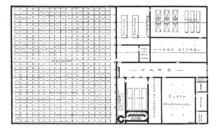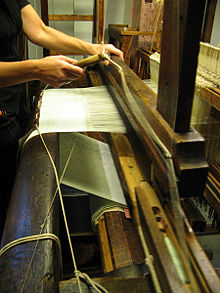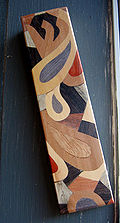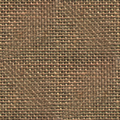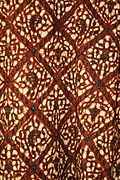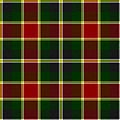- Weaving
-
- Weaver (occupation) redirects here.
This article is about textile weaving. For other uses, see Weaving (disambiguation). Warp and weft in plain weaving
Warp and weft in plain weaving
Weaving is a method of fabric production in which two distinct sets of yarns or threads are interlaced at right angles to form a fabric or cloth. The other methods are knitting, lace making and felting. The longitudinal threads are called the warp and the lateral threads are the weft or filling. The method in which these threads are inter woven affects the characteristics of the cloth.[1]
Cloth is usually woven on a loom, a device that holds the warp threads in place while filling threads are woven through them. Weft is an old English word meaning "that which is woven".[2] A fabric band which meets this definition of cloth (warp threads with a weft thread winding between) can also be made using other methods, including tablet weaving, back-strap, or other techniques without looms.[3]
The way the warp and filling threads interlace with each other is called the weave. The majority of woven products are created with one of three basic weaves: plain weave, satin weave, or twill.[4] Woven cloth can be plain (in one colour or a simple pattern), or can be woven in decorative or artistic designs.
Contents
Process and terminology
Main articles: Loom and Power LoomIn general, weaving involves using a loom to interlace of two sets of threads at right angles to each other: the warp and the weft (older woof). One warp thread is called and an end and one weft thread is a pick The warp threads are held taut and in parallel order, typically in a loom of which there are many different types. [5] Weaving can be summarised as a repetition of these three actions.
- Shedding: where the ends are separated by raising or lowering heald frames (heddles) to form a clear space where the pick can pass
- Picking:where the weft or pick is propelled across the loom by an air-jet, a rapier or a shuttle
- Beating-up or battening: where the weft is pushed up against the fell of the cloth by the reed. [6]
The principal parts of a loom are the frame, the warp-beam or weavers beam, the cloth-roll, the heddles, and their mounting, the reed. The warp-beam is a wooden or metal cylinder back of the loom on which the warp is wound. The threads of the warp extend in parallel order from the warp-beam to the front of the loom, and are attached to the cloth-roll. Each thread or group of threads of the warp passes through an opening (eye) of a heddle. The warp threads are separated by the heddles into two or more groups, each controlled and automatically drawn up and down by the motion of the heddles. In the case of small patterns the movement of the heddles is controlled by “cams” which move up the heddles by means of a frame called a harness; in larger patterns the heddles are controlled by a dobby mechanism, where the healds are raised according to pegs inserted into a revolving drum. Where a complex design is required, the healds are raised by harness cords attached to a Jacquard machine. Every time the harness (the heddles) moves up or down, an opening (shed) is made between the threads of warp, through which the pick is inserted.[7][6]
On a conventional loom, the weft thread is carried on a pirn, in a shuttle that passes through the shed. A handloom weaver would propel the shuttle by throwing it from side to side with the aid of a picking stick, on a power loom the "picking΅ is done by rapidly hitting the shuttle from each side using an overpick or underpick mechanism controlled by cams. This will happen at between 80-250 times a minute.[6] When a pirn is deplete, it is ejected from the shuttle and replaced with the next pirn held in a battery attached to the loom. Multiple shuttle boxes allow more than one shuttle to be used. Each can carry a different colour which allows banding across the loom.
The rapier-type weaving machines do not have shuttles, they propel the weft by means of small grippers or rapiers that pick up the filling thread and carry it halfway across the loom where another rapier picks it up and pulls it the rest of the way.[8] Some carry the filling yarns across the loom at rates in excess of 2,000 meters per minute. Manufacturers such as Picanol have reduced the mechanical adjustments to a minimum, and control all the functions through a computer with a graphical user interface.Other types use compressed air to insert the pick, and others small projectiles. They are all fast, versatile and quiet.[9]
The handloom weaver sizes his warp in starch mixture for smoother running. He warps his loom ( loomed or dressed) by passing the warp threads through heddles on two or more harnesses. The power weavers loom is warped by separate workers. In operation the warp threads are moved up or down by the harnesses creating a space called the shed through which the pick will pass. The harnesses can be controlled by cams, dobbies or a Jacquard head.
The raising and lowering sequence of warp threads in various sequences gives rise to many possible weave structures:
- plain weave: plain, and hopsacks, poplin, taffeta, poult and grosgrain..[10]
- twill weave: these are described by weft float followed by warp float, arranged to give diagonal pattern. 2/1 twill, 3/3 twill, 1/2 twill. These are softer fabrics than plain weaves. [4],
- satin weave: satins and sateens, [11]
- complex computer-generated interlacings.
- pile fabrics : such as velvets and velveteens [11]
Both warp and weft can be visible in the final product. By spacing the warp more closely, it can completely cover the weft that binds it, giving a warp faced textile such as repp weave.[10] Conversely, if the warp is spread out, the weft can slide down and completely cover the warp, giving a weft faced textile, such as a tapestry or a Kilim rug. There are a variety of loom styles for hand weaving and tapestry. In tapestry, the image is created by placing various colors of weft only in certain warp areas, rather than across the entire warp width.[citation needed]
History
There are some indications that weaving was already known in the Paleolithic era. An indistinct textile impression has been found at Pavlov, Moravia. Neolithic textiles are well known from finds in pile dwellings in Switzerland. One extant fragment from the Neolithic was found in Fayum, at a site dated to about 5000 BCE. This fragment is woven at about 12 threads by 9 threads per cm in a plain weave. Flax was the predominant fibre in Egypt at this time (3600 BCE) and continued popularity in the Nile Valley, though wool became the primary fibre used in other cultures around 2000 BCE.
By biblical times, weaving was known in all the great civilisation but no clear line of causality has been established. Early looms required two people to create the shed, and one person to pass through the filling. Early looms wove a fixed length of cloth but later ones allowed warp to be wound out as the fell progressed. The weavers were often children or slaves. Weaving became simpler when the warp was sized.
Easton's Bible Dictionary (1897) refers to numerous Biblical references to weaving in ancient times:Weaving was an art practised in very early times (Ex 35:35). The Egyptians were specially skilled in it (Isa 19:9; Ezek 27:7), and some have regarded them as its inventors.
In the wilderness, the Hebrews practised weaving (Ex 26:1, 26:8; 28:4, 28:39; Lev 13:47). It is referred to subsequently as specially the women's work (2 Kings 23:7; Prov 31:13, 24). No mention of the loom is found in Scripture, but we read of the "shuttle" (Job 7:6), "the pin" of the beam (Judg 16:14), "the web" (13, 14), and "the beam" (1 Sam 17:7; 2 Sam 21:19). The rendering, "with pining sickness," in Isa. 38:12 (A.V.) should be, as in the Revised Version, "from the loom," or, as in the margin, "from the thrum." We read also of the "warp" and "woof" (Lev. 13:48, 49, 51–53, 58, 59), but the Revised Version margin has, instead of "warp," "woven or knitted stuff."Islamic Golden Age
In 700 AD horizontal looms and vertical looms could be found in many parts of Asia, Africa and Europe. One of the innovations of the Islamic Golden Age was the pit-treadle loom where pedals were added to operate heddles. The first such devices appeared in Syria, Iran and Islamic parts of East Africa, where "the operator sat with his feet in a pit below a fairly low-slung loom.". Islam required the faithful to cover themselves from neck to ankle, increasing the demand for cloth. In Africa, the rich would dress on cotton while the poorer would wear wool. [12] By 1177, it was further developed in Moorish Spain, where having the mechanism was raised higher above the ground on a more substantial frame. The idea was adopted by Christian woollen weavers, particularly in Flanders. This became the standard European loom, it had the great advantage that the weavers hands were free to pass the shuttle, while the monotonous job of operating the heddles was done by the feet. [12]
Medieval Europe
Production of food was the most common occupation during the Middle Ages. Without mechanisation, artificial irrigation or knowledge of fertilizers the crop yields were low and the labour requirement to feed the population was high. Of the crafts, cloth production was the most important. The predominant fibre was wool followed by linen. Cotton was introduced to Sicily and Spain by the Muslim rulers in the 800s, and when Sicily was captured by the Normans they took the technology to Northern Italy and then the rest of Europe. Silk fabric production was reintroduced towards the end of this period and became important later when its more sophisticated weaving technology was applied to the other staples. [13]
Originally, the weaver worked at home and marketed his cloth at fairs.[13] Warp-weighted looms were commonplace in Europe until the introduction of more advanced horizontal looms in the 10th and 11th centuries. As towns developed, weaving became an urban craft. To regulate their trade, craftsmen applied to establish a guild. These initially were merchant guilds, but developed into separate trade guilds for each skill. Only a cloth merchant who was a member of that city's weavers guild was allowed to sell cloth, he acted as a middleman between the tradesmen weavers and the purchaser. The trade guilds controlled quality and the training needed before one could call himself a weaver.[13]
By the thirteenth century an organisational change took place, and a system of putting out was introduced. Here the cloth merchant purchased the wool and provided it to the weaver who sold his produce back to the merchant. The merchant controlled the rates of pay and economically dominated the cloth industry. [13] The merchants' prosperity is reflected in the wool towns of eastern England, Norwich, Bury St Edmunds and Lavenham being good examples. Wool was a political issue.[14] The supply of thread has always limited the work of a weaver. About this time, the spindle method of spinning was replaced by the Great wheel ans soon after the treadle driven spinning wheel. The loom remained the same but with the increased volume of thread it could be operated continuously. [13].
The fourteenth century saw considerable flux in population. Because the thirteenth century was was a period of relative peace Europe became overpopulated. Poor weather led to a series of poor harvests and starvation. There was great loss of life in the Hundred Years War. Then in 1346, Europe was struck with the Black Death and the population was reduced by upto a half. Arable land was labour intensive and could no longer be worked. Land prices dropped, and land was sold and put to sheep pasture. Traders from Florence and Bruges were buying the wool, but the sheep-owning landlords started to weave their own wool outside the jurisdiction of the city and trade guilds. At first the weavers worked in their own homes but production was moved into purpose build centralised buildings. Here working hours and the amount of work was regulated. The putting-out system had been replaced by a factory system. [13].
Huguenot Weavers
Main article: Huguenot WeaversReligious persecution by the Catholic monarchs of Europe led first Walloons from Flanders, and then after the Revocation of the Edict of Nantes (1685) to flee from the great silk weaving cities of France such as Lyon and Tours. The Huguenots or 'Strangers' arrived in East Kent, and were encouraged to settle in Canterbury where they worshipped in the crypt of the cathedral and then some 13,050 moved to Spitalfields in London. Some moved on to Macclesfield. In both Spitalfields and Canterbury, French speaking communities were formed. In Spitalfields there was a cluster of 11 Huguenot churches. Their importance lay not in numbers but the important weaving skills that they introduced. These Calvinists were disciplined and skillful silk weavers. Their arrival challenged the English weavers, to whom they taught their techniques and their improved technology was transfered to the wool and cotton weavers.[15]
Weaving in the American Colonies (1500-1800)
Colonial America was heavily reliant on Great Britain for manufactured goods of all kinds. British policy was to encourage the production of raw materials in colonies. Weaving was not prohibited, but the export of British wool was.[citation needed] As a result many people wove cloth from locally produced fibers . The colonists mostly used wool, cotton and flax (linen) for weaving, though hemp fiber could be made into serviceable canvas and heavy cloth also. They could get one cotton crop each fall, but until the invention of the cotton gin it was a labor-intensive process to separate the seeds from the cotton fiber. It generally took an entire year to produce cloth from raw materials, including processing, spinning, weaving and finishing. Flax and hemp were harvested in the summer, and the stalks retted to obtain the long fibers within. Wool could be sheared up to twice yearly, depending on the breed of sheep. The relative ease of processing wool, and its durability, meant that a great proportion of weaving was wool cloth.[citation needed]
A plain weave was preferred in Colonial times, and the added skill and time required to make more complex weaves kept them from common use in the average household. Sometimes designs were woven into the fabric but most were added after weaving using wood block prints or embroidery. Later, the use of multi-harness looms enabled color or texture patterns to be directly woven into the fabric.[citation needed]
Industrial Revolution
Main article: Textile manufacture during the Industrial RevolutionBefore the Industrial Revolution, weaving was a manual craft and wool was the principal staple. In the great wool districts a form of factory system had been introduced but in the uplands weavers worked from home on a putting-out system. The wooden looms of that time might be broad or narrow; broad looms were those too wide for the weaver to pass the shuttle through the shed, so that the weaver needed an expensive assistant (often an apprentice). This ceased to be necessary after John Kay invented the flying shuttle in 1733. The shuttle and the picking stick speeded up the process of weaving.[citation needed]There was thus a shortage of thread or a surplus of weaving capacity. The opening of the Bridgewater Canal in June 1761 allowed cotton to brought into the Manchester, an area rich in fast flowing streams that could be used to power machinery. Spinning was the first to be mechanised (spinning jenny, spinning mule), and this led to limitless thread for the weaver.
Edmund Cartwright was the first to attempt to mechanise weaving from 1785. He built a factory at Doncaster and obtained a series of patents between 1785 and 1792. In 1788, his brother Major John Cartwight built Revolution Mill at Retford (named for the centenary of the Glorious Revolution). In 1791, he licensed his loom to the Grimshaw brothers of Manchester, but their Knott Mill burnt down the following year (possibly a case of arson). Edmund Cartwight was granted a reward of £10,000 by Parliament for his efforts in 1809.[16] However, success in power-weaving also required improvements by others, including H. Horrocks of Stockport. Only during the two decades after about 1805, did power-weaving take hold. At that time there were 250,000 hand weavers in the UK.[17] Textile manufacture was one of the leading sectors in the British Industrial Revolution, but weaving was a comparatively late sector to be mechanised. The loom became semi-automatic in 1842 with Kenworthy and Bulloughs Lancashire Loom. The various innovations took weaving from a home-based artisan activity (labour intensive and man-powered) to steam driven factories process. A large metal manufacturing industry grew to produce the looms, firms such as Howard & Bullough of Accrington, and Tweedales and Smalley and Platt Brothers. Most power weaving took place in weaving sheds, in small towns circling Greater Manchester away from the cotton spinning area. The earlier combination mills where spinning and weaving took place in adjacent buildings became rarer. Wool and worsted weaving took place in West Yorkshire and particular Bradford, here there were large factories such as Lister's or Drummond's, where all the processes took place.[18] Both men and women with weaving skills emigrated, and took the knowledge to their new homes in New England, to places like Pawtucket and Lowell.
The invention in France of the Jacquard loom in about 1803, enabled complicated patterned cloths to be woven, by using punched cards to determine which threads of coloured yarn should appear on the upper side of the cloth. The jacquard allowed individual control of each warp thread, row by row without repeating, so very complex patterns were suddenly feasible and sample exist showing calligraphy, and woven copies of engravings. Jacquards could be attached to handlooms or powerlooms.[citation needed]
The woven grey cloth was then sent to the finishers where it was bleached, dyed and printed. Natural dyes were originally used, with synthetic dyes coming in in the second half of the nineteen century. The need for these chemicals was an important factor in the development of the chemical industry.[citation needed]
The role of the weaver
A distinction can be made between the role and lifestyle and status of a handloom weaver, and that of the powerloom weaver and craft weaver. The perceived threat of the power loom has led to disquiet and industrial unrest. Well known protests movements such as the Luddites and the Chartists had hand loom weavers amongst their leaders.
Hand loom weavers
Hand loom weavers were mainly men- due to the strength needed to batten. [19] They worked from home sometimes in a well lit attic room. The women of the house would spin the thread they needed, and attend to finishing. Later they obtained their thread from the spinning mill, and as outworkers on a piecework contract. Over time competition from the power looms drove down the piece rate and they existed in increasing poverty.
Power loom weavers
Further information: Queen Street MillPower loom workers were usually girls and young women. They had the security of fixed hours, and except in times of hardship such as in the cotton famine regular income. They were paid a wage and a piece work bonus. Even when working in a combined mill, weavers stuck together and enjoyed a tight-knit community. [20] The women usually minded the four machines and kept the looms oiled and clean. They were assisted by 'little tenters', children who on a fixed wage ran errands and did small tasks. They learnt the job of the weaver by watching.[19] Often they would be half timers, carrying a green card which teacher and overlookers would sign to say they had turned up at the mill in the morning and in the afternoon at the school.[21] At fourteen or so they come full time into the mill, and started by sharing looms with an experienced worker where it was important to learn quicky as they would both be on piece work [22]. Serious problems with the loom were left to the tackler to sort out. He would inevitably be a man, as were usually the overlookers. The mill had its health and safety issues, there was a reason why the women tied their hair back with scarves. Inhaling cotton dust caused lung problems, and the noise was total causing hearing loss. Weavers would mee-waw[23] [24]as normal conversation was impossible. Weavers used to 'kiss the shutttle' that is suck thread though the eye of the shuttle- this left a foul taste in the mouth due to the oil which was also carcinogenic.[25]
Craft Weavers
Arts and Crafts was an international design philosophy that originated in England[26] and flourished between 1860 and 1910 (especially the second half of that period), continuing its influence until the 1930s.[27] Instigated by the artist and writer William Morris (1834–1896) during the 1860s[26] and inspired by the writings of John Ruskin (1819–1900), it had its earliest and most complete development in the British Isles[27] but spread to Europe and North America.[28] It was largely a reaction against mechanisation and the philosophy advocated of traditional craftsmanship using simple forms and often medieval, romantic or folk styles of decoration. Hand weaving was highly regard and taken up as a decorative art. Female students at the Bauhaus which adopted some of its philosophy, were directed to study in the Weaving Workshop. The weaver was thus a student of art, and yet again predominantly female. With the growth of leisure in the late twentieth century, weaving became a popular pastime.[citation needed]
Other cultures
American Southwest
Main article: Navajo Weaving.
 Weaving a traditional Navajo rug
Weaving a traditional Navajo rug
Textile weaving, using cotton dyed with pigments, was a dominant craft among pre-contact tribes of the American southwest, including various Pueblo peoples, the Zuni, and the Ute tribes. The first Spaniards to visit the region wrote about seeing Navajo blankets. With the introduction of Navajo-Churro sheep, the resulting woolen products have become very well known. By the 18th century the Navajo had begun to import yarn with their favorite color, Bayeta red. Using an upright loom, the Navajos wove blankets worn as garments and then rugs after the 1880s for trade. Navajo traded for commercial wool, such as Germantown, imported from Pennsylvania.[citation needed] Under the influence of European-American settlers at trading posts, Navajos created new and distinct styles, including "Two Gray Hills" (predominantly black and white, with traditional patterns), "Teec Nos Pos" (colorful, with very extensive patterns), "Ganado" (founded by Don Lorenzo Hubbell), red dominated patterns with black and white, "Crystal" (founded by J. B. Moore), Oriental and Persian styles (almost always with natural dyes), "Wide Ruins," "Chinlee," banded geometric patterns, "Klagetoh," diamond type patterns, "Red Mesa" and bold diamond patterns. Many of these patterns exhibit a fourfold symmetry, which is thought to embody traditional ideas about harmony, or hózhó.[citation needed]
Amazonia
In Native Amazonia, densely woven palm-bast mosquito netting, or tents, were utilized by the Panoans, Tupinambá, Western Tucano, Yameo, Záparoans, and perhaps by the indigenous peoples of the central Huallaga River basin (Steward 1963:520). Aguaje palm-bast (Mauritia flexuosa, Mauritia minor, or swamp palm) and the frond spears of the Chambira palm (Astrocaryum chambira, A.munbaca, A.tucuma, also known as Cumare or Tucum) have been used for centuries by the Urarina of the Peruvian Amazon to make cordage, net-bags hammocks, and to weave fabric. Among the Urarina, the production of woven palm-fiber goods is imbued with varying degrees of an aesthetic attitude, which draws its authentication from referencing the Urarina’s primordial past.[citation needed] Urarina mythology attests to the centrality of weaving and its role in engendering Urarina society. The post-diluvial creation myth accords women’s weaving knowledge a pivotal role in Urarina social reproduction.[29] Even though palm-fiber cloth is regularly removed from circulation through mortuary rites, Urarina palm-fiber wealth is neither completely inalienable, nor fungible since it is a fundamental medium for the expression of labor and exchange. The circulation of palm-fiber wealth stabilizes a host of social relationships, ranging from marriage and fictive kinship (compadrazco, spiritual compeership) to perpetuating relationships with the deceased.[30]
See also
- Merchant capitalism
- Persian weave
- Textile manufacturing terminology
- Weaving (mythology)
- Basket weaving
- Bhuiyar
Notes
References
- ^ Collier 1974, p. 92
- ^ deriving from an obsolete past participle of weave (Oxford English Dictionary, see "weft" and "weave".
- ^ Dooley 1914
- ^ a b Collier 1974, p. 115
- ^ Collier 1974, p. 102
- ^ a b c Collier 1974, p. 104
- ^ Dooley 1914, p. 54
- ^ Collier 1974, p. 110
- ^ "Cotton: From Field to Fabric" (in American English). Memphis, Tennesee: Cotton Counts. http://www.icac.org/delegates/sc_notices/sc_meeting_506/Cotton-From-Field-to-Fabric.pdf. Retrieved 31 October 2011.
- ^ a b Collier 1974, p. 114
- ^ a b Collier 1974, p. 116
- ^ a b Pacey, Arnold (1991), Technology in world civilization: a thousand-year history, MIT Press, pp. 40–1, ISBN 0262660725, http://books.google.co.uk/books?id=X7e8rHL1lf4C&lpg=PA41&ots=25
- ^ a b c d e f Backer
- ^ George Unwin (editor) (1918). "The estate of merchants, 1336-1365: IV - 1355-65". Finance and trade under Edward III: The London lay subsidy of 1332. Institute of Historical Research. http://www.british-history.ac.uk/report.aspx?compid=33013. Retrieved 18 November 2011.
- ^ >William Page (Editor) (1911). "Industries: Silk-weaving". A History of the County of Middlesex: Volume 2: General; Ashford, East Bedfont with Hatton, Feltham, Hampton with Hampton Wick, Hanworth, Laleham, Littleton. Institute of Historical Research. http://www.british-history.ac.uk/report.aspx?compid=22161. Retrieved 18 November 2011.
- ^ W. English, The Textile Industry (1969), 89–97; W. H. Chaloner, People and Industries (1093), 45–54
- ^ Timmins
- ^ Bellerby 2005, p. 17
- ^ a b Freethy 2005, p. 62
- ^ Bellerby 2005, p. 24
- ^ Freethy 2005, p. 86
- ^ Freethy 2005, p. 70
- ^ Freethy 2005, p. 123
- ^ Bellerby 2005, p. 48
- ^ Freethy 2005, p. 121
- ^ a b Triggs, Oscar Lovell (19009). Chapters in the History of the Arts and Crafts Movement. http://books.google.com/?id=1woOAQAAIAAJ&printsec=frontcover&dq=Chapters+in+the+History+of+the+Arts+and+Crafts+Movement#v=onepage&q&f=false. Retrieved 2010-08-28.
- ^ a b Campbell, Gordon (2006). The Grove Encyclopedia of Decorative Arts, Volume 1. Oxford University Press. ISBN 9780195189483.
- ^ Wendy Kaplan and Alan Crawford, The Arts & Crafts Movement in Europe & America: Design for the Modern World, Los Angeles County Museum of Art
- ^ Bartholomew Dean 2009 Urarina Society, Cosmology, and History in Peruvian Amazonia, Gainesville: University Press of Florida ISBN 978-081303378 [1]
- ^ Bartholomew Dean. "Multiple Regimes of Value: Unequal Exchange and the Circulation of Urarina Palm-Fiber Wealth" Museum Anthropology February 1994, Vol. 18, No. 1, pp. 3–20 available online)(paid subscription).
Bibliography
- Backer, Patricia (10 June 2005), "Technology in the Middle Ages, History of Technology", Technology and Civilization (Tech 198) (San Jose, California, USA: San Jose State University), http://www.engr.sjsu.edu/pabacker/history/middle.htm#Weaving%20and%20the%20Textile%20Industry, retrieved 18 November 2011
- Bellerby, Rachel (2005), Chasing the Sixpence: The lives of Bradford Mill Folk, Ayr: Fort Publishing Ltd, ISBN 0-9547431-8-0
- Collier, Ann M (1974), A Handbook of Textiles, Pergamon Press, pp. 258, ISBN 0 08 018057 4, 0 08 018056 6
- Dooley, William H. (1914) (in American English), Project Gutenberg Textiles (Project Gutenberg ed.), Boston, USA: D.C. Heath and Co., http://www.gutenberg.org/etext/24077 Project Gutenberg, retrieved 30 October 2011
- Freethy, Ron (2005), Memories of the Lancashire Cotton Mills, Aspects of Local History, Newbury, Berkshire: Countryside Books, ISBN 978-1-84674-104-3
- Geoffrey Timmins (1993), The last shift: the decline of handloom weaving in nineteenth-century Lancashire, Manchester University Press ND, ISBN 0719037255, http://books.google.co.uk/books?id=XhoNAQAAIAAJ&pg=PA264&lpg=PA264&dq=Timmins+Last+Shift&source=bl&ots=S9dk3Tvi3k&sig=M8ApZus4X_SJApW9cWicRtkm860&hl=en&ei=SejITqO_M4vc8QOezY1c&sa=X&oi=book_result&ct=result&redir_esc=y#v=onepage&q=Timmins%20Last%20Shift&f=false
- This article incorporates text from Textiles by William H. Dooley, Boston, D.C. Heath and Co., 1914, a volume in the public domain and available online from Project Gutenberg
External links
- Encyclopædia Britannica 1911 – Weaving
- Resource collection An on-line repository of articles (4720), books (459), illustrations (271), patents (398) and periodicals (1322) relating to weaving.
- Rapier and Air-jet looms
- Card Weaving
- Oriental rug weaving
- The Worshipful Company of Weavers
Lancashire cotton Architects 
Engine makers Daniel Adamson · Ashton Frost · Ashworth & Parker · Bateman & Sherratt · Boulton & Watt · Browett & Lindley · Buckley & Taylor · Carel · Earnshaw & Holt · Goodfellow · Fairbairn · W & J Galloway & Sons · B Goodfellow · Hick, Hargreaves & Co · Benjamin Hick and Sons · John Musgrave & Sons · J & W McNaught · Petrie of Rochdale · George Saxon · Scott & Hodgson · Urmson & Thompson · Yates of Blackburn · Yates & Thom · Whilans · J & E Wood · Woolstenhulmes & RyeMachinery makers Brooks & Doxey · Butterworth & Dickinson · Curtis, Parr & Walton · Dobson & Barlow · John Hetherington & Sons · Joseph Hibbert · Howard & Bullough · Geo. Hattersley · Asa Lees · Mather & Platt · Parr, Curtis & Madely · Platt Brothers · Taylor, Lang & Co · Textile Machinery Makers Ltd · Tweedales & Smalley- Oldham Limiteds · Fine Spinners and Doublers · Lancashire Cotton Corporation · Courtaulds · Bagley & WrightIndustrial processes Textile manufacturing · Cotton-spinning machinery · Friction Spinning · Magnetic ring spinning · Open end spinning · Ring spinning · Spinning frame · Spinning jenny · Spinning mule · Water frame · Roberts Loom · Lancashire LoomLists of mills LCC mills · Bolton · Bury · Cheshire · Derbyshire · Lancashire · Manchester · Oldham · Rochdale · Salford · Stockport · Tameside · WiganMuseums Fabric Woven Aertex · Airdura · Airguard · Barathea · Barkcloth · Batiste · Bedford cord · Bengaline silk · Beta cloth · Bombazine · Brilliantine · Broadcloth · Buckram · Bunting · Burlap · C change · Calico · Cambric · Canvas · Chambray · Capilene · Cedar bark · Char cloth · Charmeuse · Charvet · Cheesecloth · Chiffon · Chino · Chintz · Cloqué · Cloth of gold · Cordura · Duck · Coutil · Crape · Cretonne · Dazzle · Denim · Dimity · Dowlas · Drill · Drugget · Foulard · Flannel · Gabardine · Gauze · Gazar · Georgette · Ghalamkar · Gingham · Grenadine · Grenfell Cloth · Grosgrain · Habutai · Haircloth · Harris Tweed · Herringbone · Himroo · Hodden · Irish linen · Jamdani · Kerseymere · Khādī · Khaki · Khaki drill · Kente cloth · Lamé · Lawn · Linsey-woolsey · Loden · Longcloth · Lumalive · Mackinaw · Madapolam · Madras · Moleskin · Muslin · Nainsook · Nankeen · Ninon · Oilskin · Organdy · Organza · Osnaburg · Ottoman · Oxford · Paduasoy · Percale · Pongee · Poplin · Rakematiz · Rayadillo · Rep · Rinzu · Ripstop · Ripstop nylon · Russell cord · Saga Nishiki · Samite · Sateen · Satin · Saye · Scarlet · Seersucker · Serge · Scrim · Shot silk · Stuff · Taffeta · Tais · Toile · Tucuyo · Tweed · Twill · Ultrasuede · Ventile · Vinyl coated polyester · Viyella · Voile · Wadmal · Wigan · Whipcord · Zephyr · ZorbeezFigured woven Pile woven Baize · Chenille · Corduroy · Crimplene · Fustian · Mockado · Moquette · Plush · Polar fleece · Terrycloth · Velours du Kasaï · Velvet · Velveteen · ZibelineNonwoven Knitted Netted Technical Ballistic nylon · Ban-Lon · Conductive · Darlexx · E-textiles · Gannex · Gore-Tex · Smartwool · Silnylon · Spandex · Stub-tex · SympaTex · WindstopperPatterns Argyle · Bizarre silk · Herringbone · Houndstooth · Paisley · Pin stripes · Tartan (Plaid) · TattersallTextile fibers Finishing and printing Androsia · Batik · Beetling · Bingata · Bògòlanfini · Calendering · Decatising · Finishing · Fulling · Heatsetting · Mercerization · Moire · Nap · Rogan printing · Rōketsuzome · Roller printing · Sanforization · Tenterhook · Textile printing · Waxed cotton · Woodblock printing · IndienneRelated Dyeing · Fiber · History of textiles · History of silk · Knitting · Pandy · Shrinkage · Synthetic fabric · Terminology · Manufacturing · Preservation · Weaving · YarnTextile arts Fundamentals Applique · Beadwork · Crochet · Dyeing · Embroidery · Fabric (textiles) · Felting · Fiber · Knitting · Lace · Macramé · Nålebinding · Needlework · Patchwork · Passementerie · Plying · Quilting · Rope · Rug making · Sewing · Stitch · Spinning · Spinning by hand · Sprang · Tapestry · Tatting · Textile printing · Weaving · YarnHistory of ... Regional and ethnic Related Blocking · Fiber art · Mathematics and fiber arts · Manufacturing · Preservation · Recycling · Textile industry · Textile Museums · Units of measurement · Wearable fiber artReference Weaving Weaves Basketweave · Charvet · Coverlet · Double weave · Even-weave · Lampas · Oxford · Pile weave · Piqué · Plain weave · Satin weave · Twill · Gabardine
Components Tools and techniques Chilkat weaving · Fingerweaving · Flying shuttle · Heddle · Ikat · Inkle weaving · Jacquard weaving · Kasuri · Loom · Navajo weaving · Salish weaving · Shed · Shuttle · Tablet weaving · Tāniko · Tapestry · TempleTypes of looms Dobby loom · Jacquard loom · Hattersley loom · Lancashire loom · Northrop loom · Power loom · Roberts Loom · Warp weighted loomWeavers Acesas · Ada Dietz · Micheline Beauchemin · Thomas Ferguson & Co Ltd · Pamphile · John Rylands · Brigitta Scherzenfeldt · Clara Sherman · Gunta Stölzl · Judocus de VosCategories:
Wikimedia Foundation. 2010.





